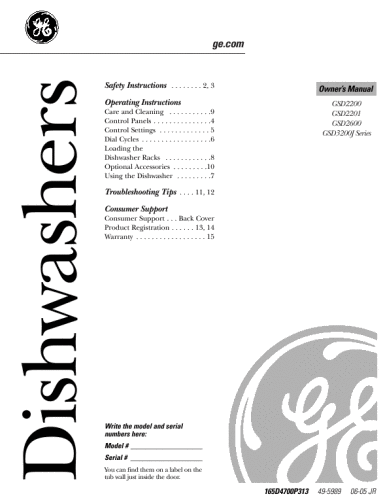O Come, O Come, E-Manual
December 20, 2009 at 10:53 PM by Dr. Drang
I spent a good deal of yesterday installing a new GE dishwasher. As always, when looking back on it, I’m dismayed that such a small accomplishment took such a long time. Some of the timewasters were:
- The tight spaces around threaded fittings that wouldn’t allow me to turn my socket wrench more than 30° or so.
- The tight spaces that wouldn’t let me use a socket wrench at all.
- The connections that needed to be made by feel while lying on the floor reaching under the machine, my arm blocking the only sight line.
- The water supply elbow that wasn’t the right size, forcing me to stop work and run off to the hardware store for a replacement. If you’ve ever done work like this, you can probably guess that the size mismatch didn’t make itself evident until the dishwasher was slid into a position that made removing the elbow quite awkward.
But I have to say the most annoying timewaster was the installation manual. GE makes dozens of dishwashers of similar design, and they use a single manual to cover many if not all of them. Because the dishwashers aren’t exactly the same, it’s common to find sections in the manual that don’t apply to your model, so you have to read carefully to avoid following the wrong directions. This checking and rechecking takes up a surprising amount of time.

I’m not blaming GE specifically. In my experience, all manufacturers use generic manuals, and they do it for TVs, refrigerators, stoves—every type of appliance. I guess they think of it the same way they think of using the same motor or power supply across several models: a standardization of parts that leads to greater economy and efficiency.
But the efficiency is all theirs, not their customers’. And I doubt there’s any real economy today in using the same manual for an entire product line.
I can understand the reasons for have multi-product manuals back in the 70s and earlier. The world of printing was different then. It was much less automated, and keeping track of manuals for dozens of dishwasher models would have been a nightmare. Not that a company with GE’s resources couldn’t have done it, but it would have been very costly when compared to the benefit.
The cost argument doesn’t hold up today and hasn’t for years. There are SGML and XML/XSLT workflows that let you define conditional sections of documents. For example, things like “this paragraph and that illustration are included in the manuals only for models SKCK2832 through SKCK2837” are fairly easy to implement. It’s just like #ifdef sections in C source code. All the information for all the models is still kept in one big document, but each model’s manual can be printed with only the relevant parts.
I should mention that despite this post’s title (which I inordinately proud of), I’m not looking for an electronic manual. I still want a printed manual, just one that uses modern technology to make it specific rather than generic. And although my complaint this weekend is with an installation manual, the same complaint holds for user manuals; they’re always filled with instructions that don’t apply to the model I bought.
The cost of creating model-specific manuals is now trivial and certainly worth it in customer satisfaction. Companies are already writing the instructions necessary for all their models; it’s just a bit of programming to hide the instructions that aren’t relevant.
Most important, it would make my Saturdays easier.
